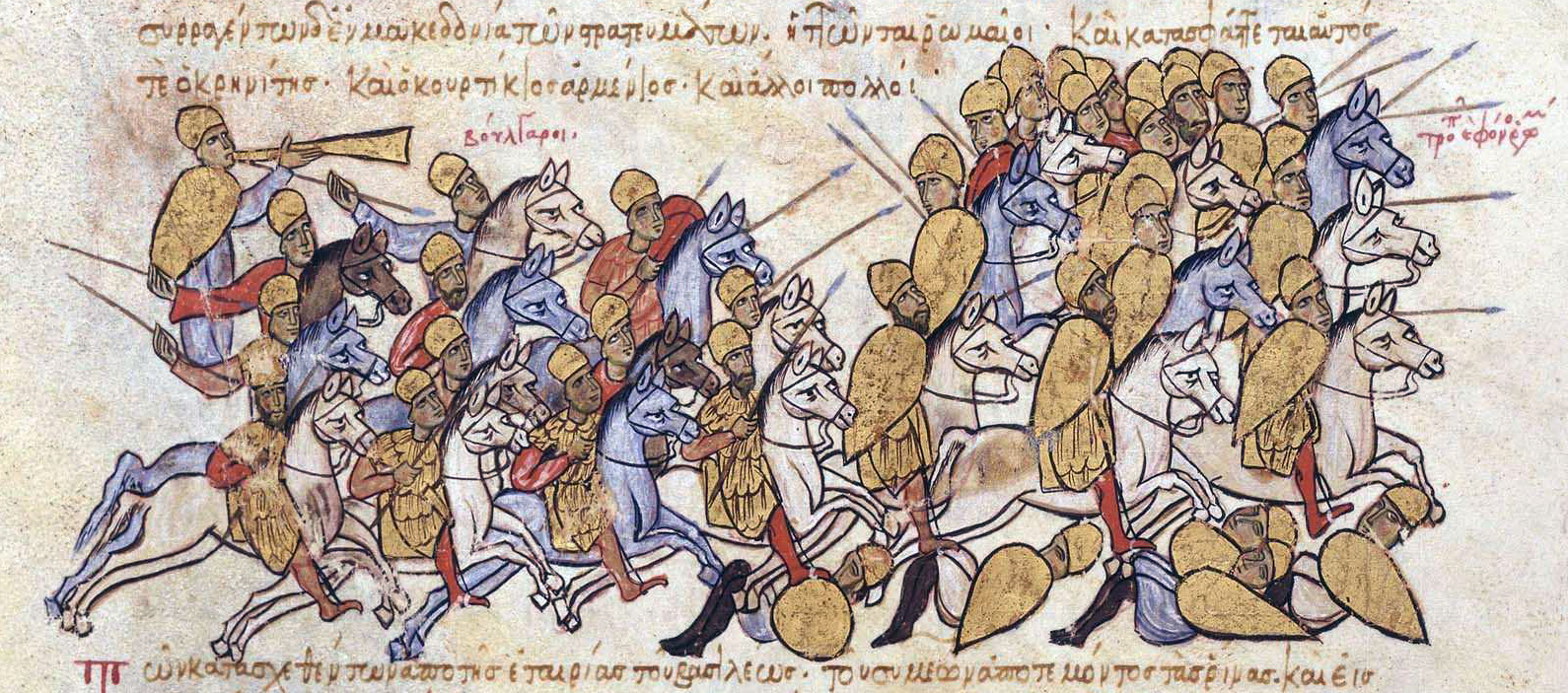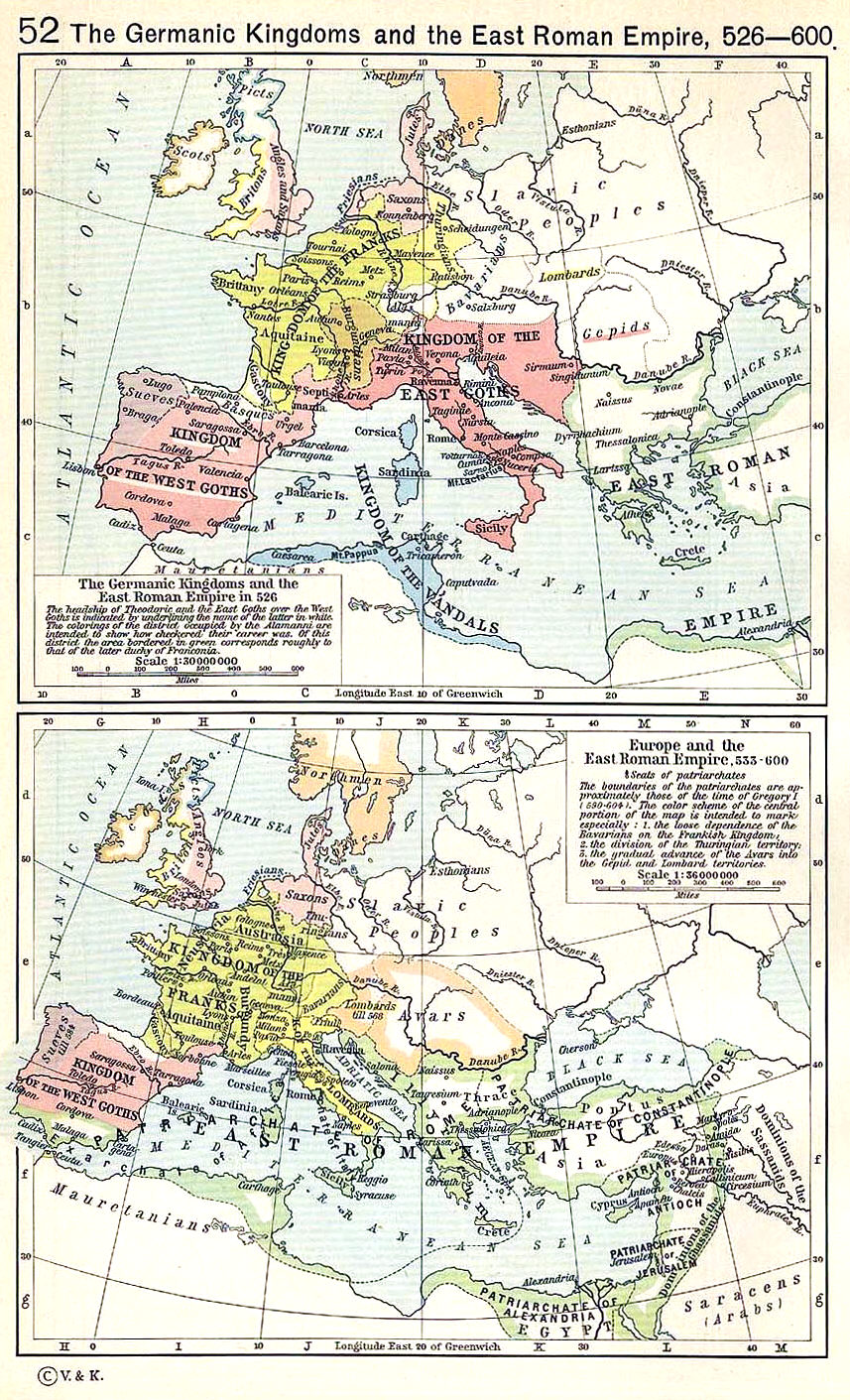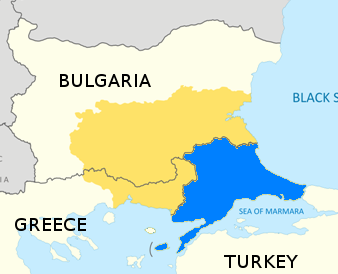|
Battle Of Boulgarophygon
The Battle of Boulgarophygon (; ) was fought in the summer of 896 near the town of Boulgarophygon (modern Babaeski, Turkey) between the Byzantine Empire and the First Bulgarian Empire. The result was an annihilation of the Byzantine army which determined the Bulgarian victory in the Byzantine–Bulgarian war of 894–896, trade war of 894–896. Despite the initial difficulties in the war against the Magyars, who acted as Byzantine allies, the battle of Boulgarophygon proved to be the first decisive victory of the young and ambitious Bulgarian ruler Simeon I of Bulgaria, Simeon I against the Byzantine Empire. Simeon would go on to inflict a number of defeats on the Byzantines in pursuit of his ultimate goal, the throne in Constantinople. The peace treaty that was signed as a result of the battle confirmed the Bulgarian domination in the Balkans. Background During the rule of Boris I of Bulgaria, Boris I (r. 852–889), Bulgaria underwent major changes – the Christianization o ... [...More Info...] [...Related Items...] OR: [Wikipedia] [Google] [Baidu] |
Madrid Skylitzes
The ''Madrid Skylitzes'' is a 12th-century illuminated manuscript version of the ''Synopsis of Histories'' () by John Skylitzes, which covers the reigns of the Byzantine emperors from the death of Nicephorus I in 811 to the deposition of Michael VI Bringas, Michael VI in 1057. The manuscript was produced at the Norman court of Palermo in Sicily (although there is some debate on whether the main body was made in Palermo or Constantinople) and is now housed in the Biblioteca Nacional de España in Madrid. It remains the only preserved Greek-language illustrated chronicle from the Byzantine period. The chronicle includes 574 Miniature (illuminated manuscript), miniatures detailing depictions of everyday life in the Byzantine Empire such as boats, literary practices, sieges, and ceremonies, in "both purely Byzantine illuminated manuscripts, Byzantine and Western styles while also reflecting Islamic miniature, Islamic elements".Helen C. Evans, Evans, Helen C. & Wixom, William D. (1997) ... [...More Info...] [...Related Items...] OR: [Wikipedia] [Google] [Baidu] |
Vladimir Of Bulgaria
Vladimir-Rasate () was the ruler of the First Bulgarian Empire from 889 to 893. Biography In 853 or 854, the Bulgar Army led by Vladimir, the son of Boris I of Bulgaria, invaded Serbia in an attempt to exact vengeance for the previous defeat of Presian in 839-842 against Vlastimir. The Serbian Army, led by Mutimir and his brothers, defeated the Bulgars, capturing Vladimir and 12 boyars.''The early medieval Balkans''p. 141/ref> Boris I and Mutimir agreed on peace (and perhaps an alliance), and Mutimir sent his sons Pribislav and Stefan to the border to escort the prisoners, where they exchanged items as a sign of peace. Boris gave them "rich gifts", while he was given "two slaves, two falcons, two dogs, and 80 furs". Vladimir became ruler ( Knyaz) of Bulgaria when his father Boris-Mihail I (Boris adopted the name Mihail - Michael - after his baptism) decided to retire to a monastery after a reign of 36 years. Preserved seals with the inscription "Michael the Monk, who i ... [...More Info...] [...Related Items...] OR: [Wikipedia] [Google] [Baidu] |
Danube
The Danube ( ; see also #Names and etymology, other names) is the List of rivers of Europe#Longest rivers, second-longest river in Europe, after the Volga in Russia. It flows through Central and Southeastern Europe, from the Black Forest south into the Black Sea. A large and historically important river, it was once a frontier of the Roman Empire. In the 21st century, it connects ten European countries, running through their territories or marking a border. Originating in Germany, the Danube flows southeast for , passing through or bordering Austria, Slovakia, Hungary, Croatia, Serbia, Romania, Bulgaria, Moldova, and Ukraine. Among the many List of cities and towns on the river Danube, cities on the river are four national capitals: Vienna, Bratislava, Budapest, and Belgrade. Its drainage basin amounts to and extends into nine more countries. The Danube's longest headstream, the Breg (river), Breg, rises in Furtwangen im Schwarzwald, while the river carries its name from its ... [...More Info...] [...Related Items...] OR: [Wikipedia] [Google] [Baidu] |
Byzantine Navy
The Byzantine navy was the Navy, naval force of the Byzantine Empire. Like the state it served, it was a direct continuation from its Roman navy, Roman predecessor, but played a far greater role in the defence and survival of the state than its earlier iteration. While the fleets of the Roman Empire faced few great naval threats, operating as a policing force vastly inferior in power and prestige to the Roman army, army, command of the sea became vital to the very existence of the Byzantine state, which several historians have called a "maritime empire". The first threat to Roman hegemony in the Mediterranean Sea was posed by the Vandals in the 5th century, but their threat was ended by the wars of Justinian I in the 6th century. The re-establishment of a permanently maintained fleet and the introduction of the dromon galley in the same period also marks the point when the Byzantine navy began departing from its late Roman roots and developing its own characteristic identity. Thi ... [...More Info...] [...Related Items...] OR: [Wikipedia] [Google] [Baidu] |
Byzantine Diplomacy
Historian Dimitri Obolensky asserts that the preservation of civilization in Southern Europe was due to the skill and resourcefulness of the diplomacy of the Byzantine Empire, which remains one of Byzantium's lasting contributions to the history of Europe and the Middle East.. Challenges and goals After the fall of the Western Roman Empire, the key challenge to the Eastern Roman Empire was to maintain a set of relations between itself and its sundry neighbors, including the Persians, Georgians, Iberians, the Germanic peoples, the Bulgars, the Slavs, the Armenians, the Huns, the Avars, the Franks, the Lombards, and the Arabs, that embodied and so maintained its imperial status. All these neighbors lacked a key resource that Byzantium had taken over from Rome, namely a formalized legal structure. When they set about forging formal political institutions, they were dependent on the empire. Whereas classical writers are fond of making a sharp distinction between peace and war, for ... [...More Info...] [...Related Items...] OR: [Wikipedia] [Google] [Baidu] |
Arabs
Arabs (, , ; , , ) are an ethnic group mainly inhabiting the Arab world in West Asia and North Africa. A significant Arab diaspora is present in various parts of the world. Arabs have been in the Fertile Crescent for thousands of years. In the 9th century BCE, the Assyrians made written references to Arabs as inhabitants of the Levant, Mesopotamia, and Arabia. Throughout the Ancient Near East, Arabs established influential civilizations starting from 3000 BCE onwards, such as Dilmun, Gerrha, and Magan, playing a vital role in trade between Mesopotamia, and the Mediterranean. Other prominent tribes include Midian, ʿĀd, and Thamud mentioned in the Bible and Quran. Later, in 900 BCE, the Qedarites enjoyed close relations with the nearby Canaanite and Aramaean states, and their territory extended from Lower Egypt to the Southern Levant. From 1200 BCE to 110 BCE, powerful kingdoms emerged such as Saba, Lihyan, Minaean, Qataban, Hadhramaut, Awsan, and ... [...More Info...] [...Related Items...] OR: [Wikipedia] [Google] [Baidu] |
Edirne
Edirne (; ), historically known as Orestias, Adrianople, is a city in Turkey, in the northwestern part of the Edirne Province, province of Edirne in Eastern Thrace. Situated from the Greek and from the Bulgarian borders, Edirne was the second capital city of the Ottoman Empire from the 1360s to 1453, before Constantinople became its capital. The city is a commercial centre for woven textiles, silks, carpets and agricultural products and has a growing tourism industry. It is the seat of Edirne Province and Edirne District.İl Belediyesi Turkey Civil Administration Departments Inventory. Retrieved 1 March 2023. Its population is 180,002 (2022). In the local elections on March 31, 2024, lawyer Filiz Gencan Akin was elected as the new mayor of the city of Edirne, succeeding Recep Gürkan, who had been ... [...More Info...] [...Related Items...] OR: [Wikipedia] [Google] [Baidu] |
Eastern Thrace
East Thrace or Eastern Thrace, also known as Turkish Thrace or European Turkey, is the part of Turkey that is geographically in Southeast Europe. Turkish Thrace accounts for 3.03% of Turkey's land area and 15% of its population. The largest city is Istanbul, which straddles the Bosporus between Europe and Asia. East Thrace is of historic importance as it is next to a major sea trade corridor and constitutes what remains of the once-vast Ottoman Empire, Ottoman region of Rumelia. It is currently also of specific geostrategy, geostrategic importance because the sea corridor, which includes Turkish straits, two narrow straits, provides access to the Mediterranean Sea from the Black Sea for the navies of five countries: Russia, Ukraine, Romania, Bulgaria, and Georgia (country), Georgia. The region also serves as a future connector of existing Turkish, Bulgarian, and Greek high-speed rail networks. Due to the guest worker agreement with Turkey and Germany, some Turks in Germany orig ... [...More Info...] [...Related Items...] OR: [Wikipedia] [Google] [Baidu] |
Macedonia (theme)
The Theme of Macedonia ( ) was a military-civilian province (theme) of the Byzantine Empire established between the late 8th century and the early 9th century. Byzantine Macedonia had limited geographical relation to the Ancient Macedonia and mainly lay in what is now the modern region of Southern Thrace. Its capital was Adrianople. History From the beginning of the 6th century, the former Roman Diocese of Macedonia, then part of the Byzantine Empire became a subject to frequent raids by Slavic tribes which in the course of next centuries, resulted in drastic demographic and cultural changes. The Slavs organized themselves into " Sklaviniai", that continued to assault the Byzantine Empire, either independently, or aided by Bulgars or Avars during the 7th century. In the late 7th century, the Byzantines organized a massive expedition against the Slavs in the area. They subdued many Slavic tribes and established a new theme of Thrace in the hinterland of Thessaloniki. Despite th ... [...More Info...] [...Related Items...] OR: [Wikipedia] [Google] [Baidu] |
Khazars
The Khazars ; 突厥可薩 ''Tūjué Kěsà'', () were a nomadic Turkic people who, in the late 6th century CE, established a major commercial empire covering the southeastern section of modern European Russia, southern Ukraine, Crimea, and Kazakhstan. They created what, for its duration, was the most powerful polity to emerge from the break-up of the Western Turkic Khaganate. Astride a major artery of commerce between Eastern Europe and Southwestern Asia, Khazaria became one of the foremost trading empires of the early medieval world, commanding the western marches of the Silk Road and playing a key commercial role as a crossroad between China, the Middle East, and Kievan Rus'. For some three centuries (–965), the Khazars dominated the vast area extending from the Volga-Don steppes to the eastern Crimea and the northern Caucasus. Khazaria long served as a buffer state between the Byzantine Empire, the nomads of the northern steppes, and the Umayyad and Abbasid Caliph ... [...More Info...] [...Related Items...] OR: [Wikipedia] [Google] [Baidu] |






